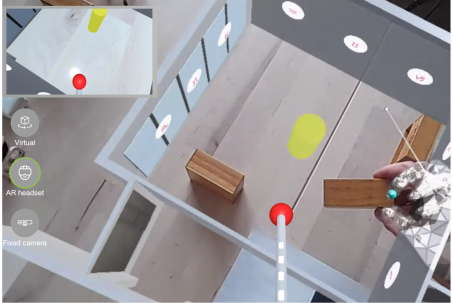Understanding Multi-View Collaboration between Augmented Reality and Remote Desktop Users
- Arthur Fages Université Paris-Saclay, CNRS, Inria, LISN, France
- Cédric Fleury IMT Atlantique, Lab-STICC, CNRS, France
- Theophanis Tsandilas Université Paris-Saclay, CNRS, Inria, LISN, France
Abstract
Establishing an effective collaboration between augmented-reality (AR) and remote desktop users is a challenge because collaborators do not share a common physical space and equipment. Yet, such asymmetrical collaboration configurations are common today for many design tasks, due to the geographical distance of people or unusual circumstances such as a lockdown. We conducted a first study to investigate trade-offs of three remote representations of an AR workspace: a fully virtual representation (Fig 1.), a first-person view (Fig 2.), and an external view (Fig 3.). Building on our findings, we designed ARgus, a multi-view video-mediated communication system that combines these representations through interactive tools for navigation, previewing, pointing, and annotation. We report on a second user study that observed how 12 participants used ARgus to provide remote instructions for an AR furniture arrangement task. Participants extensively used its view transition tools, while the system reduced their reliance on verbal instructions.



Publications
- Arthur Fages, Cédric Fleury, and Theophanis Tsandilas. 2022. Understanding Multi-View Collaboration between Augmented Reality and Remote Desktop Users. Proc. ACM Hum.-Comput. Interact. 6, CSCW2, Article 549 (November 2022), 27 pages. https://doi.org/10.1145/3555607 - Preprint: hal-03762803
- Arthur Fages, Cédric Fleury, and Theophanis Tsandilas. 2022. ARgus : système multi-vues pour collaborer à distance avec un utilisateur en réalité augmentée. In Demonstration at the conférence francophone sur l’Interaction Homme-Machine (IHM), Apr 2022
Supplementary materials
Supplementary materials can be downloaded from here: https://osf.io/g7xas.
Source code of ARgus is available here: https://github.com/argus-collab/ARgus.
